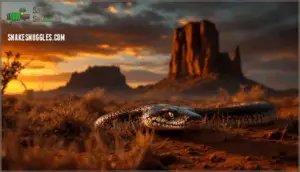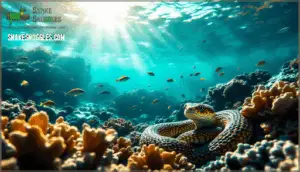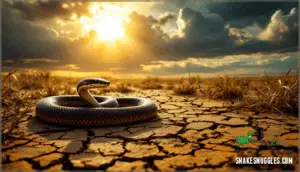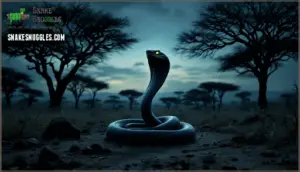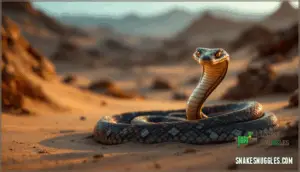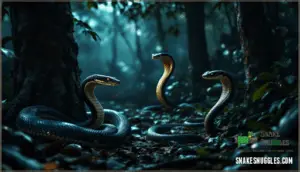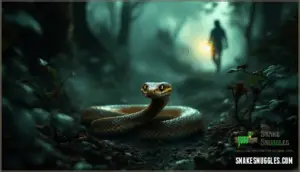This site is supported by our readers. We may earn a commission, at no cost to you, if you purchase through links.
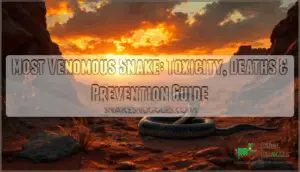
The true measure of danger isn’t venom potency alone; it’s the deadly intersection of toxicity, temperament, and proximity to human populations. While the taipan holds the biochemical crown, saw-scaled vipers kill an estimated 30,000 people annually across Asia and Africa’s agricultural heartlands.
Understanding which snakes pose the greatest threat requires examining not just the molecular weapons in their fangs, but where they strike, how aggressively they defend themselves, and whose paths they cross most frequently.
Table Of Contents
- Key Takeaways
- World’s Most Venomous Snakes
- Deadliest Snakes by Human Fatalities
- Effects of Snake Venom on Humans
- Geographic Distribution of Venomous Snakes
- Preventing and Treating Snakebites
- Frequently Asked Questions (FAQs)
- What is the 1 deadliest snake in the world?
- What are the top 3 poisonous snakes?
- Which snake venom kills the fastest?
- What is the most deadly venom in the world?
- What is the world’s largest venomous snake?
- What is a venomous snake?
- What is the most venomous snake in Australia?
- What is the deadliest snake in the world?
- Which snake has the highest venom?
- Are the world’s most venomous snakes real?
- Conclusion
Key Takeaways
- The most venomous snake by toxicity (inland taipan) isn’t the deadliest by human fatalities—the saw-scaled viper kills approximately 30,000 people annually despite having less potent venom, proving that danger stems from the intersection of toxicity, temperament, and proximity to human populations.
- Snake venom operates through three distinct mechanisms: neurotoxins shut down nerve-muscle communication causing paralysis and respiratory failure within minutes, hemotoxins destroy blood cells and clotting mechanisms leading to internal bleeding, and cytotoxins directly attack cells at the bite site causing excruciating pain and tissue necrosis.
- Geographic hotspots for snakebite fatalities cluster in rural agricultural regions of Asia and sub-Saharan Africa where the "big four" species (saw-scaled viper, Russell’s viper, Indian cobra, and common krait) overlap with dense human populations, with agricultural workers and children comprising roughly 70% of victims worldwide.
- Survival from venomous snakebites depends critically on immediate first aid (immobilizing the limb, keeping it below heart level, and calling emergency services) and rapid antivenom access, yet globally only 2.5% of victims can access antivenom due to cost barriers and inadequate healthcare infrastructure in endemic regions.
World’s Most Venomous Snakes
When you’re talking about the world’s most venomous snakes, you’re entering territory where toxicity and danger don’t always mean the same thing. Some species possess venom potent enough to kill hundreds of people with a single bite, while others combine deadly toxins with aggressive behavior or widespread distribution.
Let’s examine five snakes that stand out for their outstanding venom toxicity and the unique threats they pose to human life.
Inland Taipan: Most Toxic Venom
The inland taipan—often called the "fierce snake"—holds the title for the most toxic venom of any land snake. One bite delivers enough venom to kill 100 humans, making it a creature that commands both respect and caution.
Here’s what sets this snake apart:
- Venom composition: Its venom contains a potent enzyme that accelerates absorption into your body, causing rapid systemic effects.
- Habitat loss: Found in Australia’s arid interior, human encounters remain rare due to its remote location.
- Snake behavior: Despite its "fierce" nickname, it’s actually reclusive and avoids confrontation when possible.
Understanding venom toxicity levels helps you appreciate why conservation efforts matter—these snakes control pest populations while rarely threatening humans. The Inland Taipan’s venomous snake facts are essential to understanding its role in the ecosystem.
Dubois’ Sea Snake: Oceanic Danger
While the inland taipan reigns over Australia’s remote deserts, Dubois’ sea snake patrols tropical waters with venom nearly as lethal—a threat you won’t see coming until you’re already in its domain.
This venomous snake species inhabits shallow coastal waters and coral reefs across the Indo-Pacific, where divers and fishermen unknowingly enter sea snake habitat.
Marine venom delivers aquatic toxins through fangs smaller than a cobra’s, yet potent enough to cause paralysis within hours—oceanic threats that demand your respect and awareness.
Eastern Brown Snake: Aggressive Killer
On land, far from coral reefs and open water, the Eastern Brown Snake has earned its reputation through sheer aggression and a venom potent enough to drop an adult in minutes. You’ll find this deadly snake species thriving in farmland, grasslands, and suburban areas across Australia—snake habitat that overlaps dangerously with human activity.
When threatened, its aggressive behavior escalates instantly, delivering fatal bites with venom composition ranked among the most toxic neurotoxins globally, causing rapid paralysis and hemorrhaging that demands immediate antivenom.
Black Mamba: Rapid Fatality
If the Eastern Brown can kill in minutes, Africa’s Black Mamba makes that timeline feel generous—its neurotoxic venom shuts down your respiratory system in under 20 minutes without antivenom, earning it a fearsome reputation as one of the continent’s fastest killers.
This deadly snake species doesn’t just rely on toxicity levels; its attack patterns involve multiple rapid strikes, injecting substantial venom doses that overwhelm victims before help arrives. The fatal bite triggers cardiac arrest alongside respiratory failure, demonstrating venom composition designed for swift, lethal efficiency.
Saw-Scaled Viper: Widespread Threat
The Saw-Scaled Viper doesn’t need extreme toxicity when sheer numbers make it the world’s deadliest snake—this small, aggressively defensive species accounts for an estimated 30,000 human deaths annually across Africa, the Middle East, and Asia, more than any other serpent on Earth.
You’ll find these deadly snake species in arid viper habitats where human populations intersect with agricultural zones, triggering frequent snake bites. Their hemotoxic snake venom destroys red blood cells and tissue, while bite prevention remains challenging due to their widespread distribution and nocturnal hunting patterns.
Deadliest Snakes by Human Fatalities
When measuring danger by actual death toll rather than venom potency alone, you’ll find a different set of snakes at the top of the list. The "big four"—saw-scaled viper, Russell’s viper, Indian cobra, and common krait—kill far more people each year than their more toxic counterparts, largely due to where they live and how often humans encounter them.
Here’s what makes each of these species so deadly in practice.
Saw-Scaled Viper: Leading Cause of Death
Among venomous snakes, few match the saw-scaled viper’s lethal impact on human populations. Despite accounting for just 1.7% of medically significant snakebites in India, this species claims approximately 5,000 lives annually worldwide. Rural encounters in agricultural regions prove particularly dangerous:
- You face mortality rates between 5% and 20% depending on antivenom access
- Just 5 mg of venom can kill you, though bites yield up to 70 mg
- Your risk peaks in areas with limited medical infrastructure
- Fatal bite rates climb when treatment delays occur
- Snake habitat overlap with farmland increases your exposure
Understanding the deadly snake facts is vital for mitigating the impact of these venomous creatures. Understanding snake venom toxicity and implementing snake bite prevention strategies remains critical for your safety in rural communities.
Russell’s Viper: High Fatality Rates
Across South Asia’s monsoon-drenched farmlands, Russell’s viper strikes with devastating frequency—responsible for 43% of all medically significant snakebites in India. Your survival depends on immediate antivenom access, as mortality rates swing between 2.6% and 20%. Understanding these deadly snake species and implementing snake bite prevention measures protects you from this widespread threat.
| Russell’s Viper Factor | Impact on You | Critical Detail |
|---|---|---|
| Bite Frequency | 43% of India’s cases | Highest encounter rate among venomous snakes |
| Annual Fatalities | Tens of thousands | Most deaths during monsoon season |
| Mortality Rate | 2.6% to 20% | Depends on antivenom timing |
| Snake Habitat | Near human settlements | Rural encounters peak in agricultural zones |
Venom composition includes potent hemotoxins that trigger internal bleeding. Fatality trends reveal your greatest risk during monsoon months when snake habitat overlaps with farming activities.
Indian Cobra: Urban Encounters
Within India’s crowded streets and suburban sprawl, Naja naja presents a calculated risk you must navigate with informed vigilance. Understanding cobra habitat helps you recognize where urban encounters concentrate during monsoon months, when these venomous snakes migrate closer to human settlements seeking shelter and prey.
- Indian cobra accounts for 12% of medically relevant snake bites nationwide, causing up to 20% of fatalities among the "Big Four"
- Mortality rates span 6.4% to 20% depending on your access to rapid antivenom administration
- Adults aged 30-69 face highest risk, though children represent 25% of India’s cobra-related deaths
- Cobra behavior shifts during wet seasons, driving increased urban encounters in peri-urban zones
- Snake conservation and venom research advance toxicology understanding, improving antivenom efficacy
Internal bleeding and severe systemic symptoms demand immediate medical intervention—your survival hinges on recognizing bite signs and reaching treatment facilities without delay.
Common Krait: Nocturnal Danger
Bungarus caeruleus strikes when you’re most vulnerable—while sleeping on the floor in rural dwellings. This nocturnal habit pattern makes krait venom especially deadly, as you won’t feel the painless bite until paralysis symptoms emerge hours later.
| Factor | Impact on Rural Encounters |
|---|---|
| Bite Timing | 96% occur during nighttime attacks in homes |
| Victim Profile | Agricultural families sleeping on floors |
| Annual Deaths | Up to 10,000 in India alone |
| Treatment Challenge | Requires large polyvalent antivenom doses |
Common kraits account for 18% of medically significant snake bites across India, with mortality rates reaching 6.4% to 20% when treatment delays occur. Snakebite prevention in these deadly snake hotspots means elevating sleeping surfaces and securing homes against venomous snake species infiltration—simple measures that directly counter this serpent’s nocturnal hunting strategy.
Effects of Snake Venom on Humans
When a venomous snake bites, the venom it injects can wreak havoc on your body in different ways depending on the species. Understanding how these toxins work—whether they target your nerves, blood, or tissues—helps you recognize the danger you’re facing.
Here’s what happens when venom enters your system and why every second counts.
Neurotoxic Venom and Paralysis
When neurotoxins from species like the Black Mamba or Common Krait enter your bloodstream, they hijack nerve signals at neuromuscular junctions—in effect cutting the communication line between brain and muscle. You’ll experience:
- Drooping eyelids and blurred vision as facial muscles weaken first
- Difficulty swallowing or speaking when throat paralysis begins
- Progressive limb weakness spreading from bite site outward
- Respiratory failure as diaphragm muscles stop contracting
- Cardiac arrest if venom reaches concentrations affecting heart function
Without immediate antivenom administration, neurotoxic paralysis becomes irreversible within 20 minutes to several hours, depending on toxicity levels and venom load delivered during the strike.
Hemotoxic Venom and Tissue Damage
Hemotoxins from vipers like the Saw-Scaled or Russell’s destroy red blood cells and disrupt clotting mechanisms—your blood either clots uncontrollably or won’t clot at all. You’ll notice severe swelling, bruising spreading from the bite, internal bleeding, and tissue necrosis as enzymes liquefy muscle and skin.
Venom composition varies by species, but hemotoxic venom consistently triggers cellular breakdown, leading to organ failure if antivenom isn’t administered promptly.
Cytotoxic Venom and Painful Reactions
While hemotoxins dismantle your blood and circulatory system, cytotoxic venom takes a different approach—it attacks cells directly at the bite site, causing excruciating pain and tissue destruction that can leave permanent scars.
You’ll experience intense inflammatory responses as the venom composition triggers cell damage, potentially requiring pain management and surgical debridement.
Though cytotoxic venom toxicity levels are lower than neurotoxins or hemotoxins from certain venomous snakes, the localized agony and necrosis demand immediate medical intervention.
Snakebite Symptoms and Progression
Recognizing how venom affects your body means understanding the timeline—symptoms don’t always announce themselves immediately, and what you notice in the first minutes can shift dramatically as the toxins spread through your system.
Snake bite symptoms depend on venom toxicity and type—neurotoxins cause drowsiness and muscle weakness, while snakebite dangers include puncture wounds, swelling, and bleeding.
Proper symptom diagnosis guides pain management and treatment outcomes.
Geographic Distribution of Venomous Snakes
Venomous snakes aren’t spread evenly across the globe—they cluster in specific regions where climate, terrain, and prey create ideal conditions. From Australia’s inland deserts to Africa’s savannas and Asia’s monsoon forests, each continent harbors its own deadly species.
Let’s explore where you’re most likely to encounter these dangerous serpents and what makes each region a hotspot for venom.
Australia’s Most Dangerous Snakes
Australia’s arid heart shelters some of the planet’s most formidable deadly species. The Inland Taipan possesses the most toxic venom recorded, delivering enough toxin to kill over 100 humans with one bite.
Yet you’ll find the Eastern Brown Snake causes approximately 60% of fatal snakebites here, thriving in farmland and suburban areas where human encounters occur frequently. The Coastal Taipan’s 13mm fangs deliver massive venom volumes, while the Western Brown Snake and Tiger Snake round out this continent’s outstanding roster of venomous snakes, making bite prevention and conservation efforts essential priorities.
Africa’s Deadliest Species
Africa’s savannas and grasslands harbor serpents whose reputations for lethality stem not from possessing the most toxic venom, but from their proximity to human populations and the devastating efficiency of their strikes. The continent’s deadly snake species warrant your respect:
- Black Mamba – Delivers neurotoxins causing respiratory failure within 20 minutes, earning its reputation as Africa’s most feared serpent across safari safety protocols
- Boomslang – A rear-fanged tree dweller whose hemotoxic venom triggers uncontrollable bleeding, challenging traditional venom research classifications
- African Cobra and Desert Vipers – Thrive in varied snake habitats from urban settlements to arid regions, making encounters inevitable for local populations
Asia’s Venomous Snake Hotspots
Asia’s dense population centers and vast agricultural landscapes create what researchers term a "perfect storm" for human-snake encounters, with the Indian subcontinent alone accounting for nearly half of the world’s fatal snakebites. The "big four" deadly snake species—saw-scaled viper, Russell’s viper, Indian cobra, and common krait—dominate hotspot mapping efforts across rural farmlands where conservation efforts struggle against habitat fragmentation.
You’ll find these venomous snakes thriving in rice paddies and village outskirts, where venom research prioritizes understanding Asian species distribution patterns to reduce mortality rates.
Latin America’s Lethal Snakes
From the misty cloud forests of Central America to the sun-scorched grasslands of Argentina, Latin America harbors an arsenal of pit vipers whose hemotoxic venom turns human tissue into a battlefield of necrosis and coagulopathy.
You’ll encounter deadly snake species like:
- Fer-de-lance prowling plantations where toxicity levels trigger severe hemorrhaging
- Bushmasters concealed in rainforest undergrowth, delivering massive venom loads
- Rattlesnakes dominating arid zones where bite prevention awareness remains critically inadequate
These venomous snakes demonstrate varied venom types across diverse snake habitats throughout Latin America.
Preventing and Treating Snakebites
You can’t eliminate every risk, but you can drastically reduce your chances of a dangerous encounter. Understanding where snakebites happen most—and what to do when seconds count—can mean the difference between recovery and tragedy.
Here’s what you need to know about staying safe and responding effectively.
Bite Prevention Strategies
You won’t always be able to avoid snakes entirely, but understanding their behavior and your surroundings can dramatically reduce your risk of a dangerous encounter. When you’re in known snake habitats—grasslands, rocky areas, or dense vegetation—wear protective gear like boots and long pants. Watch for warning signs: rustling sounds or visible tracks indicate recent activity. Never attempt touching without training, and carry emergency kits in remote locations.
| Prevention Strategy | Why It Matters |
|---|---|
| Wear closed-toe boots in snake habitats | Protects against strikes to feet and ankles where most bites occur |
| Use a flashlight at night | Reveals nocturnal species like kraits before you step near them |
| Avoid tall grass and rock piles | Common snake defensive mechanisms include hiding in these areas |
| Keep hands visible when hiking | Prevents accidental contact that triggers snake bite incidents |
First Aid and Emergency Response
When a venomous snake strikes, the difference between life and death often comes down to what you do in those first critical minutes. Keep calm and call emergency services immediately—rapid response is essential.
Immobilize the affected limb and position it below heart level to slow venom circulation. Avoid tourniquets, ice, or wound cleaning attempts, as these worsen tissue damage.
Snake bite kits offer limited benefit without proper first aid training and antivenom.
Antivenom Access and Treatment
Effective antivenom administration can mean the difference between recovery and permanent disability—but globally, only 2.5% of victims have access to it. Treatment costs often exceed two weeks’ wages in endemic regions, while weak regulatory oversight has led to substandard products entering healthcare systems.
Emergency care infrastructure remains critically underdeveloped in snakebite hotspots, where delays prove fatal.
Advancing venom research and biosynthetic antivenom development offer hope for safer, more affordable snakebite treatment and prevention.
High-Risk Groups and Regions
Agricultural workers and children in rural Asia and sub-Saharan Africa bear the heaviest burden, accounting for roughly 70% of snakebite victims worldwide. These vulnerable populations face deadly snake species during harvest seasons when encounters peak in high-risk zones.
Key snakebite hotspots include:
- India’s agricultural belt, where tropical regions harbor Russell’s vipers and cobras
- Myanmar’s rice paddies, exposing workers to venomous snakes year-round
- Sub-Saharan Africa’s farmlands, where saw-scaled vipers strike barefoot laborers
- Southeast Asian plantations, creating frequent rural encounters with kraits
- Latin America’s coffee-growing regions, where snakebite dangers intensify during rainy seasons
Understanding snake geographic distribution helps identify high-risk zones and protect vulnerable communities.
Frequently Asked Questions (FAQs)
What is the 1 deadliest snake in the world?
The debate between "deadliest" and "most toxic" shapes your answer. If you’re measuring pure venom potency, the Inland Taipan dominates—its neurotoxic cocktail could theoretically kill 100 humans from a single bite.
But when it comes to actual human fatalities, the saw-scaled viper claims that grim throne, causing roughly 30,000 deaths annually through its widespread hemotoxic strikes across densely populated regions.
What are the top 3 poisonous snakes?
The three top venomous snakes—taxonomically speaking—are the Inland Taipan, with unmatched venom toxicity levels; the Eastern Brown Snake, exhibiting deadly snake behaviors and aggression; and the Black Mamba, whose neurotoxic venom causes rapid fatality across poisonous snake habitats.
Which snake venom kills the fastest?
The black mamba’s neurotoxins cause the fastest mortality time among venomous snakes. Without antivenom, its venom can trigger fatal respiratory failure in under 20 minutes, making it exceptionally dangerous when medical treatment isn’t immediately accessible.
What is the most deadly venom in the world?
Defining "most deadly" isn’t straightforward—it depends on whether you’re measuring raw toxicity levels or actual mortality rates. The inland taipan possesses the world’s most potent venom composition, containing neurotoxins capable of killing 100 humans from a single bite.
However, the saw-scaled viper causes far more human deaths annually, making venom delivery and snake behavior equally critical factors in lethality assessments.
What is the world’s largest venomous snake?
The King Cobra holds the title as the world’s largest venomous snake, reaching lengths up to 18 feet.
This massive serpent delivers neurotoxic venom in substantial quantities, making encounters particularly dangerous despite its usually reserved nature.
What is a venomous snake?
A snake is venomous when specialized glands produce toxic secretions—venom—that it injects through fangs during a bite.
This deadly cocktail contains enzymes, proteins, and peptides designed to immobilize prey or defend against threats.
What is the most venomous snake in Australia?
The Inland Taipan possesses the world’s most toxic snake venom, with a single bite containing enough neurotoxic power to kill 100 humans, though its remote Australian habitat greatly limits human encounters.
What is the deadliest snake in the world?
The saw-scaled viper claims this grim distinction, responsible for roughly 30,000 fatalities annually—more than any other deadly snake species.
Its hemotoxic venom destroys red blood cells while its aggressive temperament increases fatal bite symptoms across vulnerable populations.
Which snake has the highest venom?
Like a molecular storm in liquid form, the Inland Taipan holds nature’s deadliest title—its venom toxicity surpasses all venomous snakes.
You’re facing snake venom composition so potent that one bite could theoretically kill 100 humans, making fatal encounters exceptionally rare yet profoundly dangerous.
Are the world’s most venomous snakes real?
Yes, every species mentioned—including the Inland Taipan and saw-scaled viper—exists in nature. These venomous snakes pose genuine risks through documented deadly encounters, with toxicity levels scientifically measured and verified through reptile evolution studies.
Conclusion
Imagine if a single raindrop could end a hundred lives—that’s the staggering reality of the inland taipan, yet humans rarely cross its path. The most venomous snake by toxicity isn’t always the deadliest by body count.
Your survival depends less on knowing which species carries nature’s most potent cocktail and more on recognizing the serpents prowling near your doorstep.
Master prevention, learn proper first response, and respect the ancient hunters that shaped entire ecosystems long before we arrived.
- https://apps.des.qld.gov.au/species-search/details/?id=511
- https://www.merriam-webster.com/dictionary/succumbs
- https://www.britannica.com/list/9-of-the-worlds-deadliest-snakes
- https://greatergood.com/blogs/news/worlds-deadliest-snake-saw-scaled-viper
- https://a-z-animals.com/blog/the-worlds-4-deadliest-snakes-why-the-big-4-lead-to-50000-deaths-per-year/

